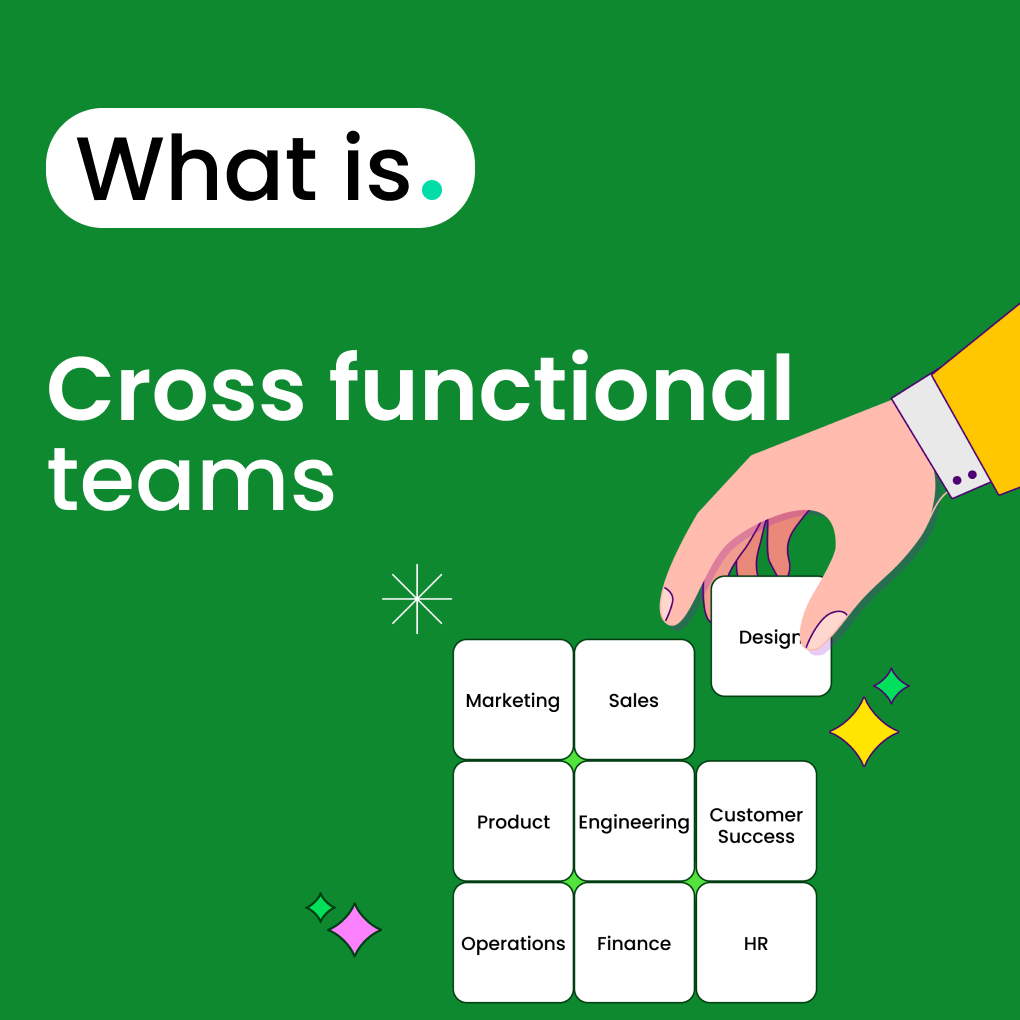Have you ever wondered how some companies manage to innovate faster than others? The secret often lies in their teamwork. In the modern business world, the knowledge to make quicker decisions to collaborate with departments is more of a necessity than an option. That’s where cross functional teams shine.
These talented groups harness expertise from your organization’s team — marketing professionals working with engineers, finance experts with product designers, and a shared mission in mind. Cross functional teams cut red tape to more quickly solve complex problems, speed product launches, and drive impactful change, unlike traditional department silos that slow anything down.
Cross Functional Team Meaning & Definition
A cross functional team is a group of people with different functional expertise working towards a common goal—teams pool skills from marketing, engineering, finance, and others to solve problems more quickly. The term “cross functional” refers to making functions work together without barriers.
What does “cross functional” mean?
Cross functional refers to collaboration that includes many departments. Employees from different areas share ideas and divide responsibilities instead of working in silos. A team may consist of a designer, an engineer, a sales expert, etc. This method, referred to as cross functional cooperation, enables firms to forge superior policies.
Cross functional vs. functional teams
People from the same department, like a marketing team or an engineering team, make up functional teams. They focus on specific tasks within their area. Cross functional teams consist of diverse members from various departments in the organization. Functional teams are used for routine work, but cross functional teams are great for complex projects that require different skills.
What is a cross functional organizational structure?
Some organizations use cross functional organizational structures in which teams are formed for projects, not departments. Employees report to a build-up manager as well as a project manager in this setup. This structure makes things more flexible and speeds up making choices. It also fosters cross-departmental working, with staff sharing expertise across different areas of the business.
Why Are Cross Functional Teams Important?
Cross functional teams help businesses solve problems more quickly and work more efficiently. These teams can provide solutions to complexities that one part may not be capable of accomplishing or dealing with. They help departments communicate more closely together to help break down the silo mentality.
Purpose and value in modern workplaces
In today’s fast-evolving businesses, flexibility and quick decision making is a must. Teams that Serve Multiple Functions Bring Expertise to the Table. When engineers, marketers, and finance pros collaborate, they produce better products more quickly. Cross functional partnerships result in innovative solutions and help companies stay competitive.
Everyday use cases and examples
Many companies use cross functional teams for key projects. Designers, engineers, and sales teams work together on product development. Marketing campaigns may need input from designers, data analysts, and customer service. Finance, operations, and human resources could work on strategy projects. Cross functional projects do well because they have the right skills at the start.
Cross functional project management basics
Successful management of a cross functional team depends on clear objectives. The leader of your cross functional team must also communicate what you all do to one another. Regular check-ins help keep the project on track. Collaboration between cross functional teams is made easier by tools like shared documents and project management software. The best teams are focused on results and respect the skills of others.
Key Benefits of Cross Functional Teams
Cross functional teams enable businesses to work smarter and faster. Bringing together many sets of skills and viewpoints, these teams are better at problem-solving. Cross functional teams offer innovation, collaboration, results, and a wealth of experience.
Diverse perspectives and problem-solving
significant advantages of a cross functional teamwork are getting multiple viewpoints on challenges. When people from different areas like engineering, marketing, and finance work together, they see problems differently. This mix of perspectives often leads to more creative solutions. A developer might spot a technical issue the marketing team misses, while finance could point out cost problems others overlook. Together, they find better answers than any single department could alone.
Better collaboration and communication
Cross functional teams break down walls between departments. Instead of working separately, team members share information freely. This open communication helps avoid misunderstandings and delays. When sales talks directly with product teams, for example, customer feedback reaches developers faster. Regular contact between different areas builds trust and makes the whole company work better together.
Faster innovation and delivery
Companies using cross functional teams often move quicker from idea to finished product. With all the needed skills in one group, projects face fewer delays. Decisions happen faster because the right people are already involved. A CFT team can test new ideas, make changes, and deliver results without waiting for approvals between departments. This speed gives businesses an edge in competitive markets.
Empowered decision-making and leadership growth
Working on cross functional projects helps employees develop new skills. Team members learn how other areas operate, making them more valuable to the company. Junior staff get chances to lead parts of projects, building leadership experience. Since these teams often make decisions together, employees feel more ownership over their work. This empowerment boosts job satisfaction and helps grow future company leaders.
How Cross Functional Collaboration Works
Cross functional collaboration involves employees from different departments working towards a common goal. It does not have walls like traditional work and encourages exchanging knowledge across teams. It helps organizations tackle complex problems and complete projects more effectively, combining varying expertise.
What is cross functional collaboration meaning?
Cross functional collaboration is when people from different departments work closely together. For instance, engineers may cross collaborate with marketers and customer service on a feature for a new product. When people from different departments work closely together, all perspectives are considered early. Cross team meaning doesn’t just getting along – it creates a scenario where different specialties contribute to the outcome.
Cross functional partnership vs. teamwork
While all teamwork involves coordination, cross functional partnerships require deeper integration. Regular teamwork might involve separate departments completing their parts sequentially. True cross functional collaboration happens when departments work simultaneously and interdependently.
Marketing doesn’t wait for product development to finish before contributing ideas – both teams work cross functionally from the start. This approach leads to better solutions and prevents last-minute conflicts between departments.
Tools and practices that support collaboration
Effective cross functional team collaboration relies on the right tools and methods. Communication platforms like Slack keep conversations organized across departments. Project management software helps track progress when multiple teams contribute to the same initiative. Daily stand-up meetings ensure alignment, while tools like Morningmate can help teams start the day focused.
The key is creating systems that make it easy to work cross functionally without unnecessary meetings or confusion. Shared documents, clear timelines, and defined roles all help cross functional collaboration run smoothly.
Common Challenges in Cross Functional Teams
Cross functional teams can enjoy many benefits; however, they also fall prey to committing an error. Conflict between different groups might lead to hurdles in project management as they have different ways of communication. Knowing the challenges prepares teams with solutions before challenges arise to facilitate smoothly collaborative cross functional teams.
Miscommunication and siloed thinking
Communication breakdown is the main hurdle in cross functional projects. People within various departments speak technical jargon that others do not use. Engineers confuse marketers with jargon, while finance workers focus on numbers that seem useless to designers so as not to confuse people from other departments. This language barrier can create misunderstandings.
Moreover, employees often find it hard to see beyond their department’s perspective and continue to think in silos, even when working together. Clear communication protocols and check-ins help in overcoming this.
Role confusion and leadership gaps
Cross functional teams often struggle with unclear responsibilities. Without defined roles, multiple people might work on the same task while other essential items get missed. Leadership gaps also create problems when no single person has the authority to make final decisions. Some members may wait for direction from their department manager rather than the team leader.
Establishing a RACI matrix (defining who is responsible, accountable, Consultable, and informed) early in the project helps prevent these issues. A strong project charter that outlines decision-making processes keeps the cross functional team moving forward efficiently.
Conflicts between departments or disciplines
Different departments often have competing priorities that cause tension in cross functional team collaboration. Marketing might push for more product features while engineering focuses on stability. Sales could demand quick launches that quality assurance teams view as risky.
These natural tensions require active management. Successful teams address conflicts directly by focusing on shared goals rather than departmental preferences. Regular alignment meetings where all perspectives get heard help find balanced solutions that serve the overall project rather than any single department’s interests.
Tips for managing remote or distributed CFTs
Remote work adds another layer of complexity to cross functional projects. Without face-to-face interaction, misunderstandings multiply, and team cohesion suffers. Time zone differences can delay decisions when key members aren’t available simultaneously. To overcome these challenges, teams should establish core collaboration hours where everyone is online.
Using video calls instead of just emails or chats helps maintain personal connections. Shared digital workspaces with clear documentation ensure all team members can access the latest information regardless of location. Most importantly, remote cross functional teams need extra effort to build trust and maintain open communication channels.
How to Build a High-Performing Cross Functional Team
An effective cross functional team is planned and structured carefully. The groups are not like the traditional teams, so they bring together diverse expertise and perspectives, which can create better results but will lead to more complexity. Having the right approach helps to combine and make use of different skills as a unit to work efficiently towards common objectives.
Set clear goals and shared KPIs
Clear goals are the starting point of all effective cross functional teams. If the purpose is not clear, the members would rather focus on their department than the team’s purpose. Focus on defining shared goals & measurable objectives. Make sure your Key Performance Indicators (KPIs) relate to the team’s objectives rather than those of individual departments. A product launch team, for example, should look at the time to market, customer satisfaction, and sales goals over-engineering milestones or marketing campaign metrics.
Assign roles and responsibilities
Clearly defining roles avoids overlaps and gaps in teamwork. Every member must know what they are supposed to do. A RACI can help to identify decision-making authority. Designers consult engineers at the correct times, and marketers include sales at the right time. When we clarify roles, there’s less room for confusion. This makes the team work faster since everyone knows who is doing what.
Choose the right leader or facilitator
Cross functional teams need strong leadership to align individual interests with the overall team purpose. The best leader knows many things and does not favor any one department. They’re capable of resolving conflicts while also bridging gaps in communication between specialties.
Sometimes, it’s best to let different members take the lead at various stages of the project, depending upon their specialization. It is essential to have an individual who can facilitate constructive discussions and timely decision-making.
Use collaboration platforms to stay aligned
Technology plays a crucial role in keeping cross functional teams coordinated. Dedicated platforms help manage tasks, share files, and maintain communication across departments. Tools like Morningmate can structure daily check-ins while project management software tracks progress.
Shared dashboards give everyone visibility into key metrics and deadlines. The proper digital workspace reduces miscommunication and ensures all team members access the same updated information regardless of their department or location.
Real-Life Cross Functional Team Examples
Cross functional teams exist in nearly every industry, solving problems that require multiple areas of expertise. These real-world cross functional team examples show how different departments combine their skills to achieve better results than they could working separately. From product launches to tech implementations, cross functional collaboration drives innovation across business functions.
Marketing & product teams
A typical example is when marketing specialists work directly with product developers. The marketing team brings customer insights about what features users want, while product engineers explain technical possibilities. Together, they create solutions that are both desirable and feasible.
This collaboration prevents situations where marketing promises features that engineering can’t deliver or where engineers build products that don’t meet market needs. Regular meetings between these teams ensure alignment from the initial concept through the final launch.
IT & operations teams
When companies implement new technology systems, IT professionals often partner with operations staff. The IT team understands the technical requirements, while operations know the daily workflow challenges. By working together, they select and customize systems that actually improve efficiency rather than disrupt work.
This collaboration is essential for enterprise software rollouts, where operations can test systems in real work conditions before full implementation. The combined team catches potential problems early, saving time and frustration.
Agile project teams in startups and tech companies
Many tech companies use cross functional teams as their new standard work model. These small teams usually comprise product owners, developers, designers, and quality assurance testers working in short sprints. Agile teams communicate every day to build, test, and improve products, unlike departments with sequential work.
This allows startups to become agile and adapt to feedback. Because everyone is in constant contact with one another, issues get fixed right away rather than wait for handovers between departments.
Conclusion
Cross functional teams are essential in today’s fast-paced business world. These teams bring together different kinds of people to solve problems faster, drive innovations, and make better decisions. Working across teams or departments is common at present, whether in product or key IT, marketing, or agile startups. Some challenges need to be looked after; sometimes, communication might get ignored, or roles can get mixed, but with clear goals, good leadership, and good tools, the teams can overcome this.
Cross functional teamwork gives companies a leg up as they can achieve results that departments cannot. Adopting this collaborative process is critical to staying agile and responsive in the ever-changing market.




